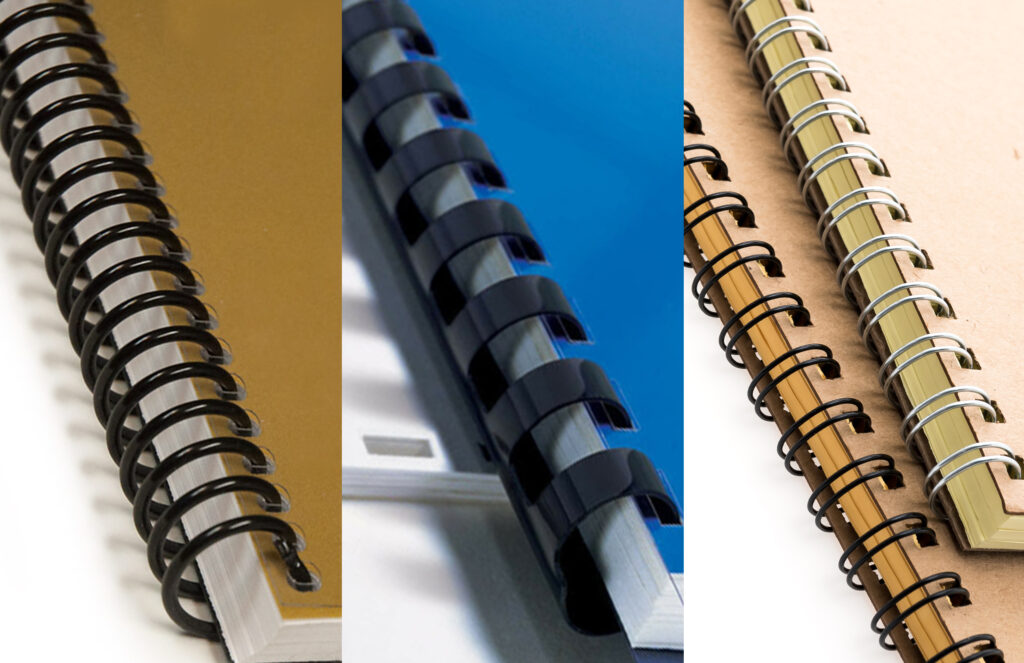
Differences Between Coil, Comb and Wire Bindings
When it comes to document binding, the choice between coil, comb, and wire bindings is a pivotal decision that impacts not only the organization and presentation of printed materials but also the efficiency of information sharing and distribution. With applications affecting diverse industries, from corporate offices to educational institutions and print shops, understanding the differences and nuances between these binding methods is essential. In this article, we delve into the distinct characteristics of coil, comb, and wire bindings, providing valuable insights for professionals, educators, and businesses seeking the perfect binding solution to elevate their document management and presentation needs.
What Are Bindings?
Bindings refer to the various methods and materials used to secure loose sheets or pages together, creating a unified document or booklet. Bindings serve multiple purposes, including organization, presentation, and protection of printed materials. They are essential in various industries, such as office settings, publishing, education, and printing, where documents need to be assembled, stored, and distributed effectively. Bindings come in various forms, each offering distinct characteristics to suit different document types and requirements. By selecting the appropriate binding method, businesses, professionals, and educators can enhance the organization and presentation of their printed materials, ultimately improving information sharing and document management.
Difference Between Coil, Comb and Wire Bindings
Each of these binding methods has distinct features, making them suitable for various applications and industries. The choice between coil, comb, and wire binding depends on factors such as document type, desired appearance, and functionality.
Coil binding, also known as spiral binding, employs a continuous plastic or metal coil that threads through closely spaced holes along the edge of the document. This method offers excellent flexibility, allowing the document to lay flat when opened, making it ideal for manuals, workbooks, and cookbooks. It is a popular choice for its versatility, offering a range of colours and sizes to match the document’s theme. While coil binding is durable, it’s not as tamper-resistant as wire binding.
Comb binding, often referred to as cerlox or plastic comb binding, employs a series of plastic comb-like spines with evenly spaced teeth that are inserted through rectangular holes punched into the document. This method is renowned for its ease of use and editability, as pages can be added or removed without damaging the document. Comb binding is perfect for reports, presentations, and training materials. While it offers convenience, the final document does not lay flat when opened, which can be a minor drawback for some applications.
Wire binding, often known as twin-loop or double-loop binding, employs metal wires, typically made of steel or other durable materials, that thread through square or round holes punched along the document’s edge. Wire binding exudes a professional look and is suitable for business reports, proposals, and legal documents. It offers durability and a secure binding, ensuring pages do not fall out. However, it may not be as convenient for editing and is not tamper-resistant like comb binding.
Which Type of Binding is Best To Use?
Choosing the right type of binding—coil, comb, or wire—depends on various factors, including the specific document or project requirements, appearance, functionality, and personal preferences. Here’s a general guide to help you decide which binding method to use:
Coil Binding (Spiral Binding):
- Ideal for documents that need to lay flat when opened, such as manuals, workbooks, and cookbooks.
- Offers excellent flexibility and durability, making it suitable for documents that require frequent use.
- Available in a range of colours and sizes to match the document’s theme.
- May not be as tamper-resistant as wire binding.
Comb Binding (Plastic Comb or Cerlox Binding):
- Convenient for documents that may require frequent editing or the addition/removal of pages, such as reports, presentations, and training materials.
- Ensures pages lay flat when opened.
- Easy to use and allows for document customization.
- May not offer the same level of professionalism as wire binding.
Wire Binding (Twin-Loop or Double-Loop Binding):
- Best suited for creating a professional, sleek appearance, making it perfect for business reports, proposals, and legal documents.
- Provides durability and secure binding to prevent pages from falling out.
- Ensures a polished finish for important documents.
- Less convenient for editing or adding/removing pages compared to comb binding.
Ultimately, the choice between coil, comb, and wire binding depends on the specific needs of your document and the impression you want to convey. Consider factors like the type of content, document size, frequency of use, and desired aesthetics when deciding. Additionally, it’s advisable to consult with a professional or supplier who can provide guidance based on your unique requirements.
Best Binding Machines in 2023
Let’s explore the best binding machines in 2023, each offering unique features to suit different document binding needs.
Best Coil Binding Machines
- Coilbind S12 Spiral Coil Binding Machine
- Coilbind S-15 Manual Spiral Coil Binding Machine
- CoilBind S25A Spiral Coil Binding Machine
- Akiles Duo Mac 321
- SUPU PC360E Electric Coil Binding Machine 14″
Best Comb Binding Machines
- C-12 Comb Binding Machine
- CombBind C20A Comb Binding Machine
- Akiles Duo Mac 321
- CombBind C20A Comb Binding Machine
Best Wire Binding Machines
- WireBind W20A Wire Binding Machine
- Supu CW430E Electric Wire-o Punching Machine with Manual Closer
- WireMac-E31 Akiles Electric Punch Manual Wire
- Akiles WBM532 Modular Wire Binding Machine
- Akiles FlexiCloser 2 Wire Binding Machine
The choice between coil, comb, and wire bindings comes down to the specific needs and preferences of the user. Each method brings its own set of advantages and limitations, making them suitable for different applications. By understanding these differences, individuals and businesses can make informed decisions that enhance the presentation, organization, and functionality of their printed materials. Whether it’s the flexibility of coil, the editability of comb, or the professional finish of wire, the binding method you choose is a vital aspect of effective document management and communication.
For business owners seeking the ultimate edge in document binding, it’s time to elevate your efficiency, presentation, and document management with the best binding machines. Whether you run an office, a binding business, or a printing enterprise, the right binding machine can make all the difference. Explore our range of cutting-edge options designed to streamline your processes and enhance your printed materials. Contact us today to find the perfect binding solution that aligns with your unique needs and stay ahead in the competitive world of document management. Your journey to superior binding starts here.











